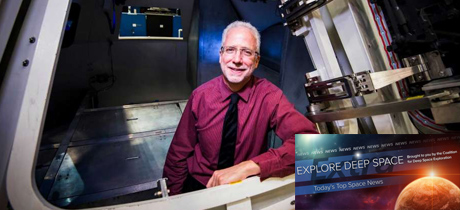In Today’s Deep Space Extra… NASA’s Mark Geyer named as the next Director of the Johnson Space Center. A new study suggests that Jupiter’s ice and ocean covered moon Europa is a source of eruptive plumes that could mean it hosts a habitable environment. Australia forms a space agency.
Human Space Exploration
Mark Geyer named new director of NASA’s Johnson Space Center
Houston Chronicle (5/15): Mark Geyer will succeed Ellen Ochoa as director of NASA’s Johnson Space Center, home to the agency’s astronaut corps, Mission Control, and the engineers who lead the development of human spacecraft. Ochoa, who in 1993 became the first female Hispanic astronaut, will retire as director May 25 after more than five years in the post. Geyer, who joined NASA as an engineer in 1990, has served as Johnson’s deputy director, Orion program manager and several International Space Station (ISS) program positions.
Space Science
Europa is venting water into space, old spacecraft data suggest
Sciencemag.org (5/14): NASA’s long concluded Galileo mission to Jupiter has produced new evidence of a watery plume rising from the ice and ocean covered moon Europa. The observation, originally made by Galileo in December 1997, was recently re-assessed and modeled by a science team led by the University of Michigan’s Xianzhe Jia. Galileo appears to have soared through a plume more than 600 miles wide, while making the lowest of 11 passes close to Europa as it orbited Jupiter between 1995 and 2003. Jia and members of his team joined NASA executives in endorsing a new NASA mission, Europa Clipper, to carry out more than 40 future close flybys of Europa to assess whether it possesses a habitable environment. The discovery was reported in the journal Nature Astronomy.
How asteroids may have brought water to Earth
New York Times (5/15): A study led by scientists at Johns Hopkins and Brown universities supports the prospect that impacts billions of years ago from asteroids could have been a major source of the water that covers about 70 percent of the Earth. For years planetary scientists have weighed comets and asteroid impacts as the primary source of water on Earth.
China preparing to launch Chang’e-4 relay satellite May 21
Space News (5/14): A Chinese communications satellite planned for a May 21 liftoff is to set the stage for an attempt late this year by China to soft land a spacecraft on the far side of the Moon. The communications satellite will head for the Earth/Moon L-2 Lagrange point to serve as a relay for the lander. The lander’s destination is believed to be near the South Pole Aitkin Basin, which has value both scientifically as well as for future lunar development.
Recovered asteroid 2010 WC9 set to buzz the Earth tomorrow
Universe Today (5/14): Discovered nearly eight years ago, then lost track of, the 71 meter wide WC9 asteroid has been spotted again and will pass by the Earth at half the distance to the moon on Tuesday at 6:05 p.m., EDT. The space rock does not pose an impact threat to the Earth, say experts.
Other News
New Space Agency boss predicts booming sector could produce 20,000 Australian jobs
Australian Broadcasting Corp. (5/14): This week marks the startup of the Australian Space Agency, a move that promises to spark the creation of thousands of new jobs. But the outcome appears to depend on regional and local collaborations. “We are creating the jobs of the future, it’s not about creating another NASA, this is about what Australia does best and capitalizing on that,” said Australian Senator Michaelia Cash, who participated in the agency launch.

